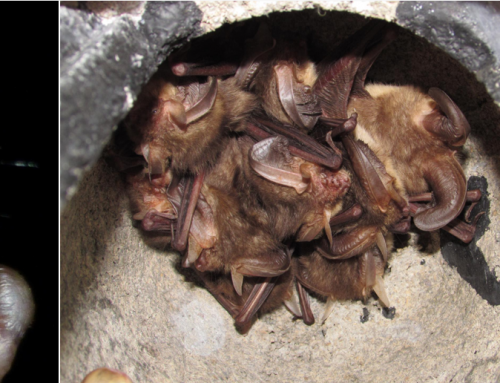by Claire Andrews
1st draft, more photos to follow
After writing off the Nathusius’ pipistrelle trapping project for another year, this time frustratingly not because of Covid but because the Natural England licence had not come through as expected in April, we were surprised to hear in mid-August that the licence had finally been agreed. We scrambled to find some dates when enough of us were available, Rose-Ann jumped on organising access and meeting arrangements and Bob booted up kit that had not been used for two seasons.
To take advantage of availability and good weather, we surveyed two of our sites back-to-back. On the Friday night we headed out to our most reliable site, the BBOWT Hosehill reserve. We set up just three harp traps and lures, abandoning any ideas of mist nests after bats started arriving thick and fast in the traps straight after sunset.
Covid has introduced a more streamlined protocol: rather than fully processing all bats at a central point, as many bats as possible (ie all bats that can be identified at the trap) are quickly processed by the traps for immediate release. This change took a little getting used to and meant things felt a little frantic at first but still that evening we caught and ringed three Nathusius’ pips, all three young males, plus another 30 bats, soprano and common pips and Daubentons, the majority of them females.
The next night we headed over to Caversham lakes, also a site where we have caught Nathusius’, including a just-volant juvenile male in 2018, and again set out three traps. We had caught 27 bats, the usual soprano and common pips and Daubentons, but no Nathusius’ pips, despite picking them up on the detector.
It got to about 1.30am, we hadn’t had any bats for a while so we decided it was probably time to call it a night, setting off in teams to take the traps down. Just as we were finishing putting ours down the call came over the radio that there was a small myotis in one of the traps and did I want to see it.
The bat had already been processed, Brandt’s had been eliminated based on penis shape, but he was very small for a whiskered bat, weighing in at just 3.7g with a forearm of 32.5mm which meant that we had to consider Myotis alcathoe, a species never previously recorded in our area. I wasn’t convinced, the base of the ear and tragus weren’t particularly pale, so, concerned about his weight, we released him without further ado, but luckily not before he left us a little package of DNA.
Bob recorded a release call and I sent all the photos off to people who have more experience with these little chaps. Answers were inconclusive from the selection of photos we had as we had initially been checking features to rule out Brandt’s. But we sent off the poo for DNA analysis and two weeks later ………..drum roll….. it has come back as Myotis alcathoe!
The name Alcathoe (pronounced “al-ca-THO-ee”) derives from Greek myth where Alcathoe, daughter of Minyas, having spurned Dionysus was turned into a bat! The species was first described in Greece in 2001 and subsequently confirmed in just two areas in England in 2010 (Yorkshire and Sussex). Since then it has been more widely recorded across Sussex and Surrey with the only known maternity roost in a dwelling being in Surrey.
The call we recorded is typical of the other Myotis bat calls but has a distinguishing feature in that it typically terminates between 43-46 kHz, significantly higher than the calls of whiskered and Brandt’s bats.
So this is a very unusual record for the area and poses a few questions being a juvenile male caught so late on in the evening. Is this evidence of the Surrey population expanding or do we have a resident population in the area? You will note I am avoiding using the words “county” and “first for county” because as Rose-Ann pointed out our trapping location is, somewhat frustratingly, just the wrong side of the little dotty black line on the map and was actually caught 100m into Oxfordshire!



